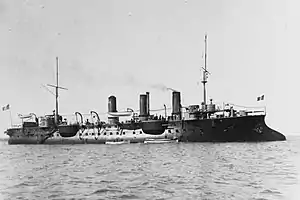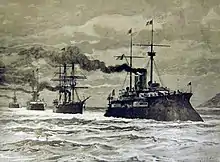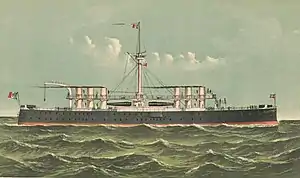Friant-class cruiser
The Friant class comprised three protected cruisers of the French Navy built in the early 1890s; the three ships were Friant, Bugeaud, and Chasseloup-Laubat. They were ordered as part of a naval construction program directed at France's rivals, Italy and Germany, particularly after Italy made progress in modernizing its own fleet. The plan was also intended to remedy a deficiency in cruisers that had been revealed during training exercises in the 1880s. As such, the Friant-class cruisers were intended to operate as fleet scouts and in the French colonial empire. The ships were armed with a main battery of six 164 mm (6.5 in) guns supported by four 100 mm (3.9 in) guns and they had a top speed of 18.7 knots (34.6 km/h; 21.5 mph).
 Friant in port, date unknown | |
| Class overview | |
|---|---|
| Name: | Friant class |
| Builders: | |
| Operators: |
|
| Preceded by: | Alger class |
| Succeeded by: | Linois class |
| Built: | 1891–1896 |
| In commission: | 1895–1920 |
| Completed: | 3 |
| Retired: | 3 |
| General characteristics | |
| Type: | Protected cruiser |
| Displacement: | 3,809–3,982 long tons (3,870–4,046 t) |
| Length: | 94 m (308 ft 5 in) pp |
| Beam: | 12.98 m (42 ft 7 in) |
| Draft: | 6.30 m (20 ft 8 in) |
| Installed power: |
|
| Propulsion: | |
| Speed: | 18.7 knots (34.6 km/h; 21.5 mph) |
| Range: | 6,000 nmi (11,000 km; 6,900 mi) at 10 kn (19 km/h; 12 mph) |
| Complement: | 339 |
| Armament: |
|
| Armor: |
|
Friant and Chasseloup-Laubaut initially served with the Northern Squadron, while Bugeaud operated in the cruiser force of the Mediterranean Squadron, France's main battle fleet. Bugeaud became the flagship of the Levant Division in 1898, which operated as part of the International Squadron that intervened in the Cretan Revolt of 1897–1898. All three members of the class were sent to East Asia in response to the Boxer Uprising in Qing China by 1901, and they remained in the region through the mid-1900s. Bugeaud was badly worn out by her time in the Far East, and she was sold for scrap in 1907. That year, Chasseloup-Laubat visited the United States during the Jamestown Exposition.
Chasseloup-Laubat was reduced to a storage hulk in 1911, but Friant remained in active service through the start of World War I in August 1914. She operated with cruiser squadrons patrolling for German commerce raiders early in the war and was later sent to patrol the formerly-German colony of Kamerun. Chasseloup-Laubat was converted into a distilling ship to support the main French fleet at Corfu while Friant ended the war having been rebuilt into a repair ship. The latter vessel was sold for scrap in 1920, while Chasseloup-Laubat ultimately foundered in 1926 after having been abandoned in the bay of Nouadhibou, French Mauritania.
Design
In the late 1880s, the Italian Regia Marina (Royal Navy) accelerated construction of ships for its fleet and reorganized the most modern ironclad battleships—the Caio Duilio and Italia classes—into a fast squadron suitable for offensive operations. These developments provoked a strong response in the French press. The Budget Committee in the French Chamber of Deputies began to press for a "two-power standard" in 1888, which would see the French fleet enlarged to equal the combined Italian and German fleets, then France's two main rivals on the continent. This initially came to nothing, as the supporters of the Jeune École doctrine called for a fleet largely based on squadrons of torpedo boats to defend the French coasts rather than an expensive fleet of ironclads. This view had significant support in the Chamber of Deputies.[1]
The next year, a war scare with Italy led to further demands to strengthen the fleet. The visit of a German squadron of four ironclads to Italy compounded French concerns about a combined Italo-German fleet that would dramatically outnumber their own. Training exercises held in France that year demonstrated that the slower French fleet would be unable to prevent the faster Italian squadron from bombarding the French coast at will, in part because it lacked enough cruisers (and doctrine to use them) to scout for the enemy ships.[2]
To correct the weaknesses of the French fleet, on 22 November 1890, the Superior Naval Council authorized a new construction program directed not at simple parity with the Italian and German fleets, but numerical superiority. In addition to twenty-four new battleships, a total of seventy cruisers were to be built for use in home waters and overseas in the French colonial empire. The Friant class were the first group of protected cruisers to be authorized under the program.[2][3]
General characteristics and machinery

The ships of the Friant class were 94 m (308 ft 5 in) long between perpendiculars, with a beam of 12.98 m (42 ft 7 in) and a draft of 6.30 m (20 ft 8 in). They displaced 3,809 to 3,982 long tons (3,870 to 4,046 t). The ships' hulls featured a pronounced ram bow and a tumblehome shape, which were common characteristics of major French warships of the period. They had a forecastle deck that extended for almost the entire length of the ship, terminating with a short quarterdeck aft and a sloped stern. Their superstructure consisted of a main conning tower with a bridge forward and a smaller, secondary conning tower aft. Each ship was originally to be fitted with a pair of heavy military masts with fighting tops, but stability problems with Friant forced them to be replaced with lighter pole masts carrying only observation positions. Steering was controlled by a single rudder.[4][5] Chasseloup-Laubat was fitted with bilge keels to improve her stability.[6] Their crew consisted of 339 officers and enlisted men.[4]
The ships' propulsion system consisted of a pair of triple-expansion steam engines driving two screw propellers. Steam was provided by twenty coal-burning water-tube boilers of the Niclausse type for Friant and the Lagrafel d'Allest type for Chasseloup-Laubat, while Bugeaud received twenty-four Belleville boilers. All of the ships' boiler rooms were ducted into three funnels. Their machinery was rated to produce 9,500 indicated horsepower (7,100 kW) for a top speed of 18.7 knots (34.6 km/h; 21.5 mph). During sea trials, Bugeaud reached 19 knots (35 km/h; 22 mph).[7] Coal storage amounted to 577 long tons (586 t),[4] which provided a cruising range of 6,000 nautical miles (11,000 km; 6,900 mi) at a speed of 10 knots (19 km/h; 12 mph).[8]
Armament and armor
._Pi%C3%A8ce_de_100_de_marine_-_Fonds_Berthel%C3%A9_-_49Fi1270_(cropped).jpg.webp)
The ships were armed with a main battery of six 164 mm (6.5 in) 45-caliber guns. They were placed in individual pivot mounts; one was on the forecastle, two were in sponsons abreast the conning tower, another pair were in sponsons just forward of the aft conning tower, and the last was on the stern.[4] They were supplied with a variety of shells, including solid, 45 kg (99 lb) cast iron projectiles, and explosive armor-piercing (AP) and semi-armor-piercing (SAP) shells that weighed 54.2 kg (119 lb) and 52.6 kg (116 lb), respectively. The guns fired with a muzzle velocity of 770 to 800 m/s (2,500 to 2,600 ft/s).[9]
The ships' offensive armament was augmented by a secondary battery of four 100 mm (3.9 in) Modèle 1891 guns, which were carried in pivot mounts in the conning towers, one on each side per tower.[4] The guns fired 14 kg (31 lb) cast iron and 16 kg (35 lb) AP shells with a muzzle velocity of 710 to 740 m/s (2,300 to 2,400 ft/s).[10] All of the primary and secondary guns were fitted with gun shields to protect their crews. The offensive weaponry was rounded out by two 350 mm (14 in) torpedo tubes that were carried in their hulls above the waterline, one on either side.[4]
For close-range defense against torpedo boats, they carried a battery of numerous small-caliber, quick-firing guns. This comprised four 47 mm (1.9 in) 3-pounder Hotchkiss guns and eleven 37 mm (1.5 in) 1-pounder guns, all in individual mounts. The former were carried in pairs in the forward and aft conning towers on the upper deck; the latter were distributed around the ships, including atop the sponsons for the main guns and higher in the superstructure.[4]
Armor protection consisted of a curved armor deck that was 30 mm (1.2 in) thick on the flat, which increased to 80 mm (3.1 in) on the sloped sides, where it provided a measure of vertical protection. Above the deck at the sides, a cofferdam filled with cellulose was intended to contain flooding from damage below the waterline. Below the main deck, a thin splinter deck covered the propulsion machinery spaces to protect them from shell fragments. Their forward conning towers had 75 mm (3 in) thick plating on the sides. The gun shields were 50 mm (2 in) thick.[4]
Construction

| Name | Laid down[4] | Launched[11] | Completed[4] | Shipyard[4] |
|---|---|---|---|---|
| Friant | 1891 | 17 April 1893 | April 1895 | Arsenal de Brest, Brest |
| Bugeaud | June 1891 | 29 August 1893 | May 1896 | Arsenal de Cherbourg, Cherbourg |
| Chasseloup-Laubat | June 1891 | 17 April 1893 | 1895 | Arsenal de Cherbourg, Cherbourg |
Service history

Friant and Chasseloup-Laubat spent their first years in service assigned to the Northern Squadron, based in the English Channel.[12] Bugeaud was instead assigned to the Mediterranean Squadron, France's primary battle fleet.[13] In both units, the ships were primarily occupied with training exercises. In 1898, Bugeaud transferred to serve as the flagship of the Levant Division in the eastern Mediterranean. During that time, she participated in the International Squadron, composed of ships from several of the Great Powers, that intervened in the Cretan Revolt of 1897–1898.[15]
Bugeaud was deployed to East Asia by early 1900 in response to the Boxer Uprising,[16] and the other two members of the class had followed her there by 1901,[17] and they remained in the region after the conflict ended.[18] After returning to France in the mid-1900s, Friant received new boilers and thereafter returned to fleet operations.[19] Meanwhile, the poor shipyard facilities in the Far East prevented sufficient maintenance being done for Bugeaud, and she was in a poor state by 1907. Unable to economically repair her, the French Navy struck the ship from the naval register and sold her for scrap.[11][20] That year, Chasseloup-Laubat took part in a visit to the United States for the Jamestown Exposition.[21] She was later hulked in 1911 and disarmed in 1913.[11]
At the start of World War I in August 1914, Friant was on station in France's colonies in the Americas.[22] She was initially assigned to a cruiser squadron to patrol the western end of the English Channel.[23] In September, she was moved to French Morocco to join a group of cruisers patrolling for German commerce raiders.[24][25] At some point after the start of the conflict, Chasseloup-Laubat was converted into a distilling ship to support the main French fleet at Corfu.[11][26] Friant was later moved to the Gulf of Guinea to patrol Germany's colony of Kamerun in western Africa.[24] She ended the war having been converted into a repair ship based in Morocco and later at Mudros to support a flotilla of submarines. She was struck from the naval register in 1920 and sold to ship breakers.[11] Chasseloup-Laubat was sent to Port Etienne, French Mauritania, to supply the colony with water and eventually sank in 1926 in the bay of Nouadhibou after having been abandoned.[27]
Notes
- Ropp, p. 195.
- Ropp, pp. 195–197.
- Gardiner, pp. 310–311.
- Gardiner, p. 311.
- Brassey 1895, p. 23.
- Weyl, p. 28.
- France, p. 37.
- Garbett 1904, p. 563.
- Friedman, p. 221.
- Friedman, p. 225.
- Gardiner & Gray, p. 193.
- Brassey 1896, p. 62.
- Thursfield, pp. 164–167.
- Clowes, pp. 444–448.
- Service Performed, p. 299.
- Jordan & Caresse 2017, p. 218.
- Brassey 1902, p. 51.
- Garbett 1907, p. 1538.
- Brassey 1904, pp. 90–91.
- Sieche, pp. 150, 155, 157.
- Jordan & Caresse 2019, p. 219.
- Meirat, p. 22.
- Jordan & Caresse 2019, p. 227.
- Corbett, p. 275.
- Saint-Ramond, p. 60.
- Pavé, pp. 17–18.
References
| Wikimedia Commons has media related to Friant class cruisers. |
- Brassey, Thomas A. (1895). "Ships Building In France". The Naval Annual. Portsmouth: J. Griffin & Co.: 19–28. OCLC 496786828.
- Brassey, Thomas A. (1896). "Chapter III: Relative Strength". The Naval Annual. Portsmouth: J. Griffin & Co.: 61–71. OCLC 496786828.
- Brassey, Thomas A. (1902). "Chapter III: Relative Strength". The Naval Annual. Portsmouth: J. Griffin & Co.: 47–55. OCLC 496786828.
- Brassey, Thomas A. (1904). "Chapter IV: Comparative Strength". The Naval Annual. Portsmouth: J. Griffin & Co.: 86–107. OCLC 496786828.
- Clowes, William Laird (1903). The Royal Navy: A History From the Earliest Times to the Death of Queen Victoria. VII. London: Sampson Low, Marston and Co. OCLC 632971260.
- Corbett, Julian Stafford (1920). Naval Operations: To the Battle of the Falklands, December 1914. I. London: Longmans, Green & Co. OCLC 174823980.
- "France". Notes on the Year's Naval Progress. Washington, D.C.: United States Office of Naval Intelligence. XV: 27–41. July 1896. OCLC 727366607.
- Friedman, Norman (2011). Naval Weapons of World War One: Guns, Torpedoes, Mines and ASW Weapons of All Nations; An Illustrated Directory. Annapolis: Naval Institute Press. ISBN 978-1-84832-100-7.
- Garbett, H., ed. (May 1904). "Naval Notes: France". Journal of the Royal United Service Institution. London: J. J. Keliher & Co. XLVIII (315): 560–566. OCLC 1077860366.
- Garbett, H., ed. (1907). "Naval Notes: France". Journal of the Royal United Service Institution. London: J. J. Keliher & Co. LI: 47–55. OCLC 1077860366.
- Gardiner, Robert, ed. (1979). Conway's All the World's Fighting Ships 1860–1905. London: Conway Maritime Press. ISBN 978-0-85177-133-5.
- Gardiner, Robert & Gray, Randal, eds. (1985). Conway's All the World's Fighting Ships: 1906–1921. Annapolis: Naval Institute Press. ISBN 978-0-87021-907-8.
- Jordan, John & Caresse, Philippe (2017). French Battleships of World War One. Annapolis: Naval Institute Press. ISBN 978-1-59114-639-1.
- Jordan, John & Caresse, Philippe (2019). French Armoured Cruisers 1887–1932. Barnsley: Seaforth Publishing. ISBN 978-1-5267-4118-9.
- Meirat, Jean (1975). "Details and Operational History of the Third-Class Cruiser Lavoisier". F. P. D. S. Newsletter. Akron: Foreign Periodicals Data Service. III (3): 20–23. OCLC 41554533.
- "Naval Notes: France". Journal of the Royal United Service Institution. London: J. J. Keliher & Co. XLII (247): 1091–1094. September 1898. OCLC 1077860366.
- Pavé, Marc (1997). Documents figurant dans les archives de l'Afrique Occidentale française (série Affaires agricoles, sous-série Pêche).: Tableaux thematiques des dossiers 1 à 16 (PDF). série Affaires agricoles, sous-série Pêche (in French). Centre de recherches océanographiques de Dakar-Thiaroye. OCLC 61349656.
- Ropp, Theodore (1987). Roberts, Stephen S. (ed.). The Development of a Modern Navy: French Naval Policy, 1871–1904. Annapolis: Naval Institute Press. ISBN 978-0-87021-141-6.
- Saint-Ramond, Francine (2019). Les Désorientés: Expériences des soldats français aux Dardanelles et en Macédoine, 1915-1918 (in French). Presses de l’Inalco. ISBN 978-2-85831-299-3.
- "Service Performed by French Vessels Fitted with Belleville Boilers". Notes on Naval Progress. Washington, D.C.: United States Office of Naval Intelligence. 20: 299. July 1901. OCLC 699264868.
- Sieche, Erwin F. (1990). "Austria-Hungary's Last Visit to the USA". Warship International. XXVII (2): 142–164. ISSN 0043-0374.
- Thursfield, J. R. (1897). Brassey, Thomas A. (ed.). "Naval Maneouvres in 1896". The Naval Annual. Portsmouth: J. Griffin & Co.: 140–188. OCLC 496786828.
- Weyl, E. (1898). Brassey, Thomas A. (ed.). "Chapter II: The Progress of Foreign Navies". The Naval Annual. Portsmouth: J. Griffin & Co.: 19–55. OCLC 496786828.

